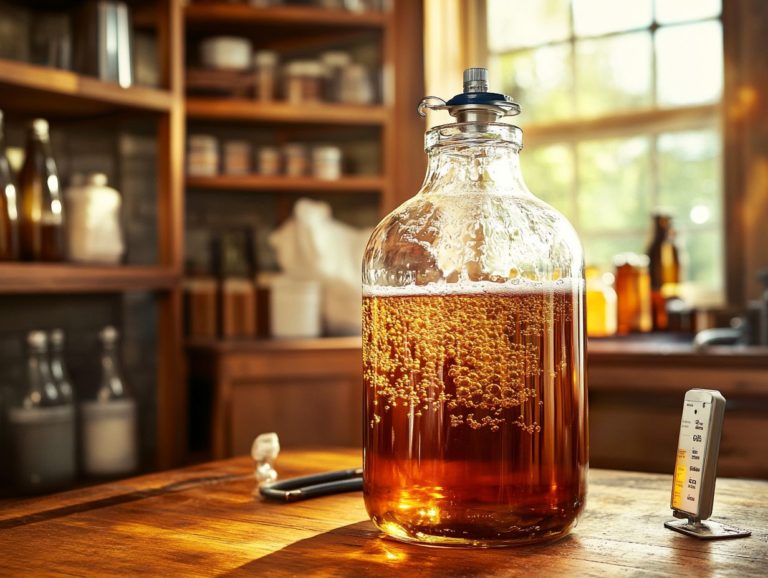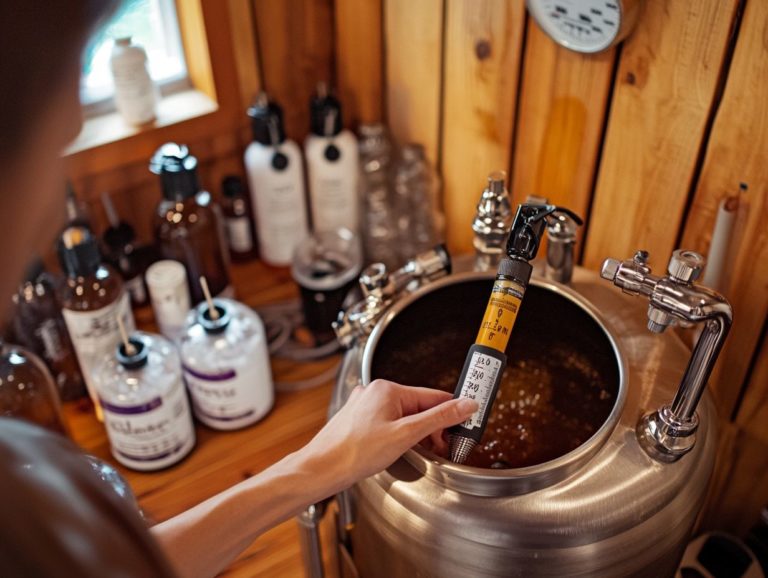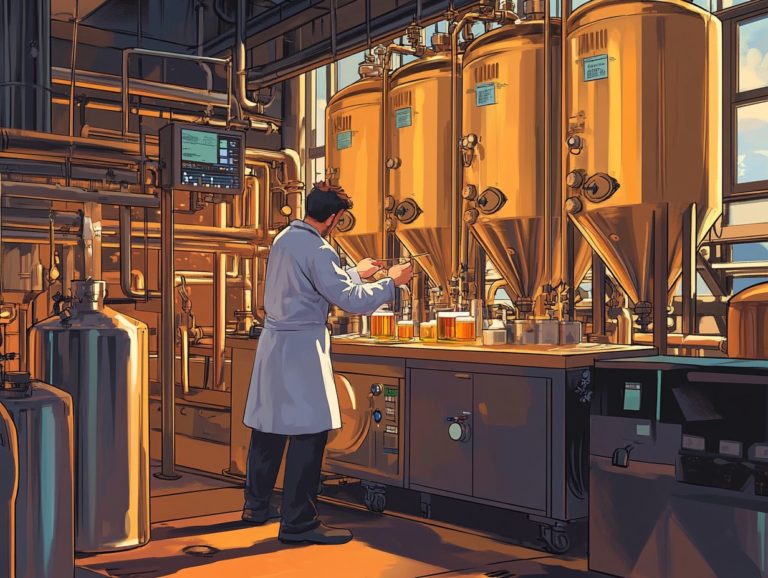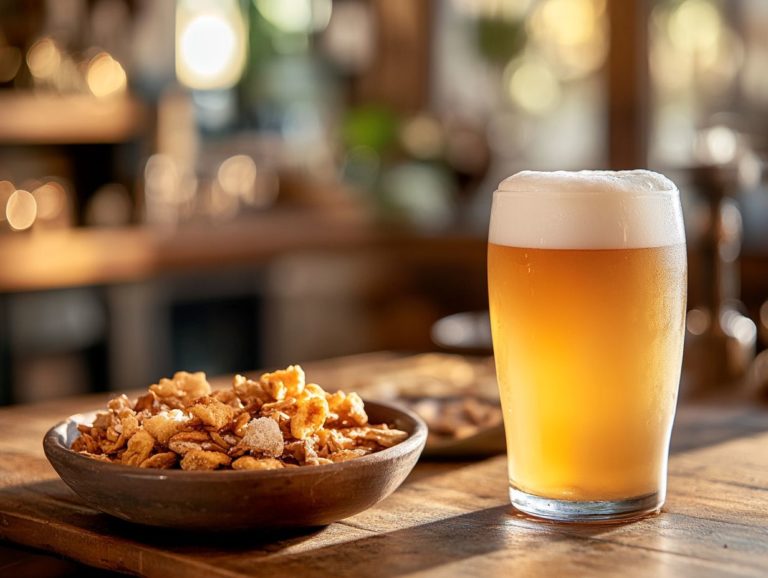How to Detect Off-Flavors Early in Brewing
In the realm of brewing, the quality of your beer relies on a meticulous balance of flavors. Off-flavors such as esters and phenolic flavors can swiftly undermine even the most carefully crafted recipes.
Recognizing these unwelcome tastes early on, such as cidery aroma and green-apple flavor, is vital for preserving the integrity of your brew.
This article delves into essential detection methods and prevention strategies, shedding light on common offenders like diacetyl, DMS, and oxidation.
Regardless of whether you’re a seasoned brewer or just embarking on your extract brewing journey, honing these skills will undoubtedly elevate your brewing expertise.
Contents
- Why Is It Important to Detect Off-Flavors Early?
- How to Detect Off-Flavors Early?
- What Are Off-Flavors in Beer?
- 4. Oxidation
- 5. Infection
- How Can You Prevent Off-Flavors in Brewing?
- Frequently Asked Questions
- What are off-flavors in brewing, and why is it important to detect them early?
- What are some common off-flavors found in beer, such as esters or sour flavors, and how can they be detected early?
- How does sensory analysis, including beer tasting and beer evaluation, help in detecting off-flavors early in brewing?
- What role do chemical tests play in detecting off-flavors early in brewing?
- How can monitoring the brewing process, including fermentation, help detect off-flavors early?
- What steps can be taken to prevent off-flavors and ensure quality beer styles like Oktoberfest and bock?
Key Takeaways:
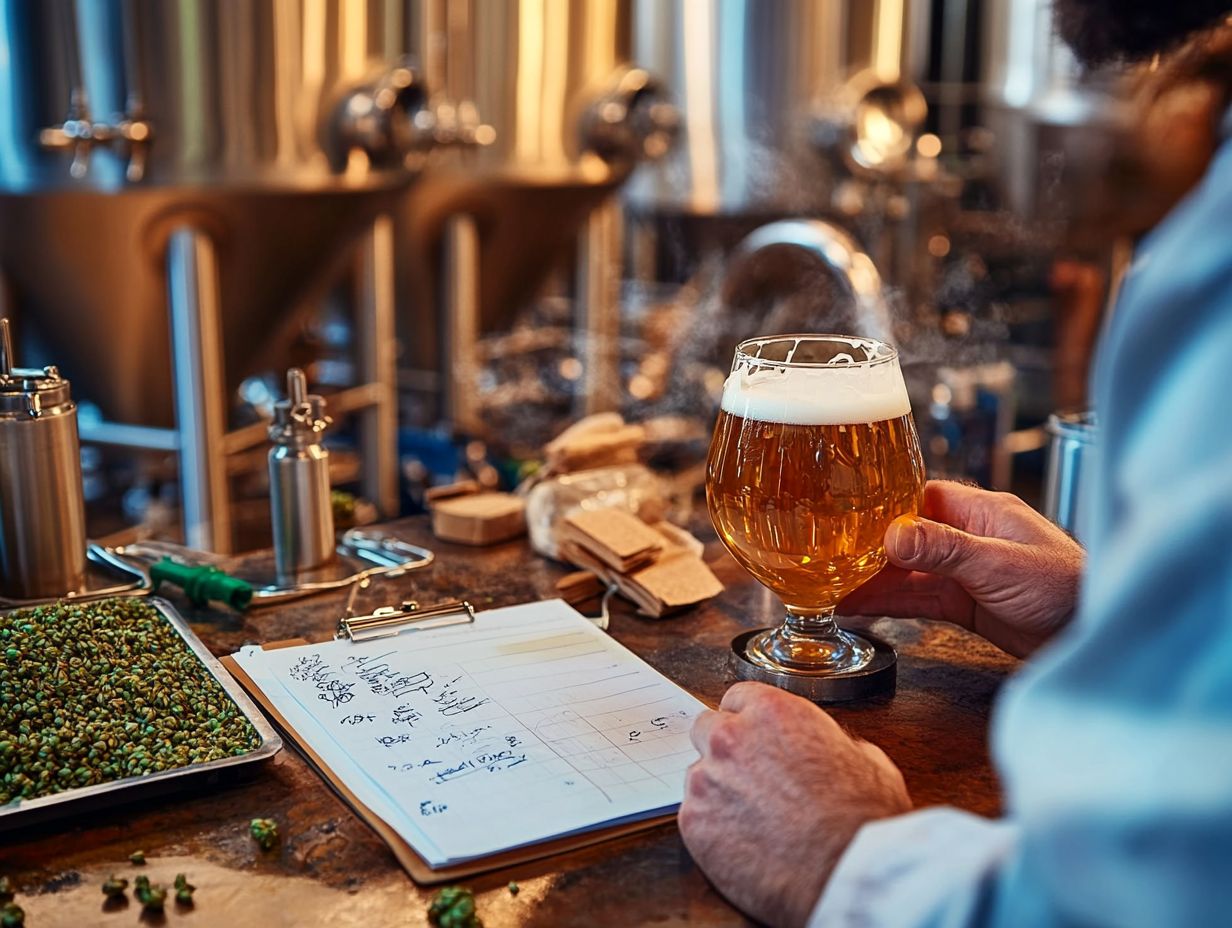
- Detect off-flavors early to ensure quality beer, preventing issues like overly-sweet or cloyingly sweet profiles.
- Use senses, sensory analysis, brewing water testing, and testing kits to detect off-flavors.
- Prevent off-flavors by maintaining sanitation, controlling temperature, using quality ingredients, monitoring pH levels, and proper storage and handling, including beer storage techniques.
Why Is It Important to Detect Off-Flavors Early?
Detecting off-flavors early in the brewing process is essential for ensuring the quality and enjoyment of your beer.
These off-flavors often serve as telltale signs of underlying issues, such as inadequate sanitation practices or yeast health concerns.
By identifying these undesirable flavors whether they manifest as overly sweet profiles or unexpected sour notes you can save a batch from potential disaster and guarantee that the final product meets the high standards established by organizations like the BJCP.
Employing proper brewing techniques will elevate the taste of your creations and prevent off-flavors, ultimately leading to a more gratifying experience for those who savor your beer.
How Do Off-Flavors Affect the Quality of Beer?
Off-flavors can critically impact the quality of your beer, altering its intended profile and making it less enjoyable for you and other beer enthusiasts.
For example, when a pale ale develops diacetyl, a compound that gives a buttery flavor that feels out of place for this typically hoppy and crisp style.
On the other hand, an overabundance of esters can turn a lager’s clean finish into a chaotic fruit salad of flavors, straying far from its original crispness.
Acetaldehyde may also create an unwanted green-apple flavor in most beer styles.
The brewing process is key in the emergence of these off-flavors. Factors such as temperature control during fermentation, the quality of your ingredients, and your sanitation practices can significantly influence flavor thresholds.
Using a yeast strain like Wyeast American Ale can help control these issues. By understanding how these elements interact, you can effectively mitigate unwanted tastes and preserve the integrity of your brews.
What Are the Consequences of Not Detecting Off-Flavors Early?
Failing to detect off-flavors early in your brewing process can have serious repercussions, resulting in subpar beer that doesn t quite meet quality standards and leaves beer drinkers unsatisfied.
The fallout doesn t stop with disappointed customers; it can also lead to negative evaluations from beer judges, which may dampen your brewery’s chances for accolades and recognition in competitions.
Consistently producing beer with off-flavors can tarnish your brand s reputation, eroding loyalty among enthusiasts and leading to a decline in market share.
To navigate these challenges, adhering to established brewing practices is essential. By implementing stringent quality control measures and providing regular training for your staff on flavor detection, you can elevate the overall tasting experience and reinforce your commitment to excellence.
This proactive approach can dramatically protect your reputation and set your beer apart in a crowded market!
Start applying these detection techniques today to ensure your next brew is a masterpiece!
How to Detect Off-Flavors Early?
Detecting off-flavors early is crucial for you as an extract brewer. You can achieve this through a combination of methods, including sensory analysis, using testing kits, and maintaining a keen eye on the fermentation process and fermentation temperature range.
Each of these approaches empowers you to identify potential issues before they compromise the quality of your brew.
1. Use Your Senses
Using your senses is one of the most effective ways to detect off-flavors in beer. Aromas and tastes can reveal subtle yet significant flaws, like cidery notes, fruity flavors, or green-apple flavors that just don t quite hit the mark.
Engaging all five senses during the beer tasting process cultivates a more nuanced understanding of each brew. Start with sight; observing the beer s color and clarity provides initial insights into its quality.
As you bring the glass closer, let those distinct aromas waft under your nose. They play a crucial role in identifying unique characteristics and potential defects.
Taste is paramount. The interplay of flavors on your palate can either highlight a beer s complexity or expose unwelcome elements. Pay attention to the mouthfeel as well whether it s smooth, creamy, or astringent, these sensations can greatly influence your overall enjoyment.
Don t underestimate the power of sound; actively listening to the bubbling or carbonation when pouring can even give you clues about the beer s freshness. Utilizing these senses effectively enhances your ability to recognize specific off-flavors, like diacetyl or skunkiness, allowing you to appreciate beer on a deeper level. This is key for a beer judge during evaluation sessions.
2. Conduct Sensory Analysis
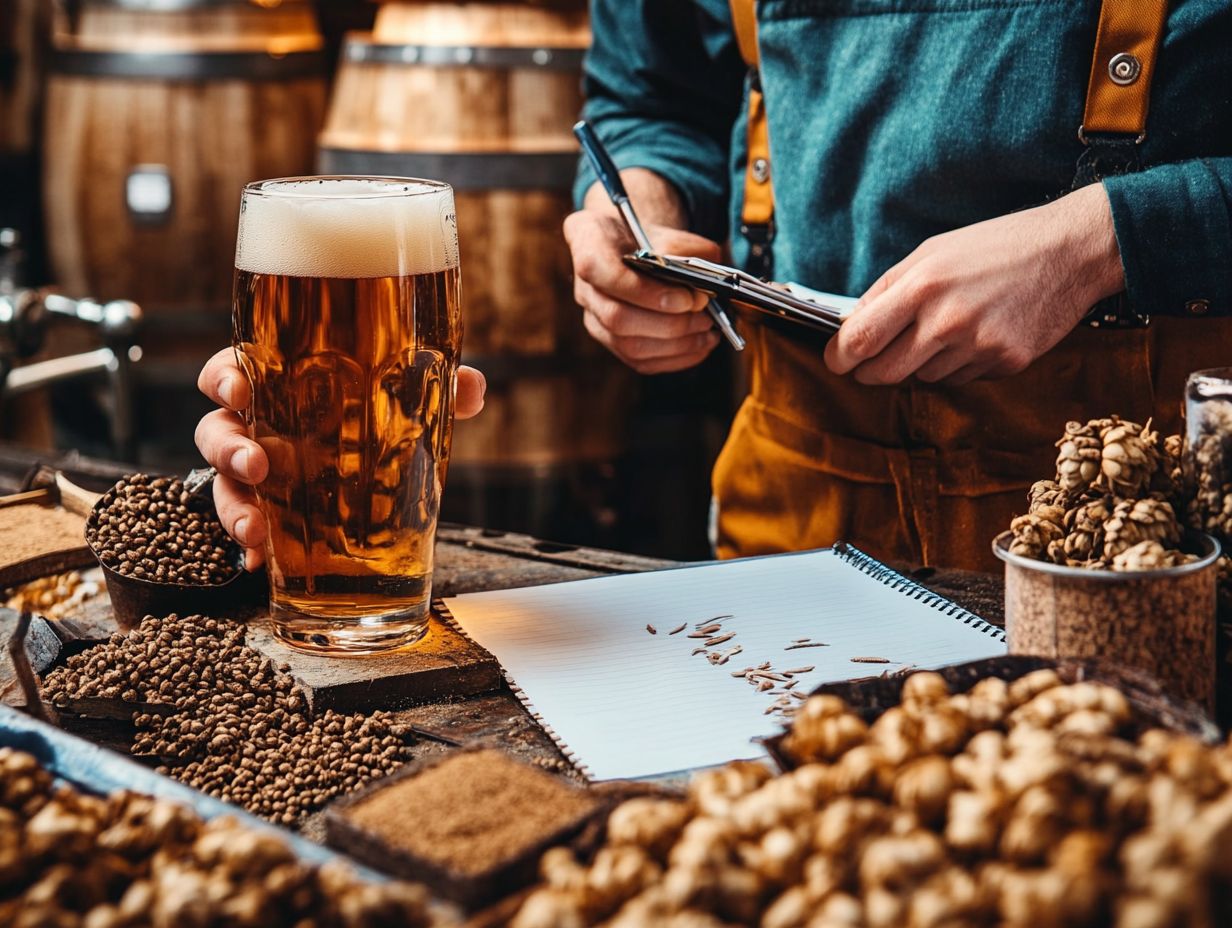
Conducting sensory analysis is an essential step in pinpointing off-flavors. This analytical process involves assembling a well-chosen tasting panel comprised of individuals trained in taste tests.
These judges assess an array of flavor compounds, utilizing specific terminologies and methodologies as outlined by the Beer Judge Certification Program (BJCP). Such panels often include certified beer judges who provide expert insights into the beer’s profile.
Creating an effective panel requires a controlled environment, free from distractions, to ensure that participants can concentrate solely on the beer presented. While trained judges bring a wealth of knowledge and experience, casual beer drinkers offer a relatable perspective, bridging the gap between intricate flavor profiles and the average consumer’s palate. This comprehensive approach aids in beer evaluation.
Together, their insights culminate in a thorough understanding of the beer’s qualities.
3. Utilize Testing Kits
Testing kits can transform your brewing game! They help pinpoint off-flavors and potential sources of contamination. These kits are equipped to test various elements in your brewing water and the fermentation process, including the detection of acetaldehyde and lactic acid bacteria contamination.
You’ll find that these specialized testing kits come in several varieties, including those designed to monitor pH levels, detect certain microorganisms, and evaluate the concentration of dissolved oxygen. Each kit employs straightforward yet effective methods, such as colorimetric analysis a process that uses color changes to indicate the presence of certain compounds or sensor technology, offering you invaluable insights into your brewing environment.
By identifying off-flavors like diacetyl, which lends a buttery taste, or the funky characteristics of Brettanomyces yeast, you can take corrective measures to refine your brewing processes. This knowledge not only addresses sanitation issues but also contributes to the development of a more consistent and high-quality product, ensuring your customers enjoy an exceptional experience with every sip. Proper use of malt extract and hop alpha acids can also contribute to this consistency.
What Are Off-Flavors in Beer?
Common off-flavors in beer include diacetyl, DMS (dimethyl sulfide), acetaldehyde, oxidation, and infection. Each presents unique challenges that brewers and tasters must navigate using a keen palate and a discerning approach. Infections can arise from bacterial contamination, like Lactobacillus, Pediococcus, and Acetobacter.
1. Diacetyl
Diacetyl gives beer a buttery taste, often reminiscent of popcorn or buttered toast. This flavor results from yeast byproducts during fermentation, especially when yeast health and fermentation temperatures aren t carefully monitored. Diacetyl can significantly affect your beer s sensory profile and can overshadow the intended flavors.
Several factors contribute to diacetyl formation, including insufficient yeast pitching rates, poor fermentation management, and stress on yeast due to fluctuating temperatures. Aging beer under controlled conditions and proper handling are also crucial. Fortunately, you have strategies to mitigate or eliminate diacetyl issues.
Select yeast strains known for low diacetyl production and employ effective fermentation management techniques. Gradually increasing temperatures toward the end of fermentation encourages yeast to reabsorb diacetyl. Yeast health and proper selection are critical in this process.
Regularly monitoring and tasting your brew is crucial for spotting early signs of diacetyl. This proactive approach allows timely adjustments, helping maintain your beer s flavor integrity.
2. DMS (Dimethyl Sulfide)
DMS, or dimethyl sulfide, often manifests as a cooked corn taste. It can occur if sanitation practices and ingredient handling are overlooked during brewing. Great brewing practices will ensure you avoid DMS!
When present in excessive amounts, DMS can undermine your beer s character and overall quality. This compound primarily arises during the malting process, particularly from certain malt types rich in precursor compounds. Insufficient evaporation or shortened boil times can inadvertently elevate DMS levels.
Combat DMS with strategies like using high-quality grains, maintaining long and vigorous boiling periods, and ensuring rapid cooling of your wort. Choosing well-processed malts is crucial in preventing DMS development, so make sure your ingredient selection is on point.
3. Acetaldehyde
Acetaldehyde presents itself as a distinct green-apple flavor in beer, serving as a potential red flag for fermentation process issues, particularly when yeast health is compromised.
This undesirable compound typically arises during yeast metabolism, especially when fermentation is incomplete or the yeast is under stress. Be mindful of factors like temperature fluctuations, exposure to oxygen, and nutrient deficiencies that can elevate acetaldehyde levels in your brew.
Utilize sensory evaluation alongside gas chromatography to detect this off-flavor accurately. Implement practical measures like ensuring proper pitching rates, maintaining consistent fermentation temperatures, and incorporating yeast nutrients to effectively reduce the risk of acetaldehyde production. By doing so, you will enhance the quality and flavor profile of your beers.
4. Oxidation

Oxidation can introduce unwanted off-flavors in your beer, creating light-struck flavors and sherry-like notes that often stem from subpar storage practices or light exposure.
This chemical process unfolds when oxygen mixes with the components of the beer, particularly during brewing and bottling. This leads to significant changes in the taste profile and overall quality. As this reaction intensifies, it can amplify undesirable flavors while dulling the fresh, vibrant qualities that define a well-crafted brew.
To combat oxidation, it s crucial to minimize oxygen exposure throughout the brewing process, from fermentation to packaging. Ensure proper bottle conditioning by sealing the final product in a way that restricts oxygen ingress.
Store your beer in dark, temperature-controlled environments to shield it from damaging light and heat, effectively preserving the intended flavor experience.
5. Infection
Infection in beer, often caused by bacteria like Lactobacillus or Pediococcus, can introduce off-flavors such as lactic acid, significantly altering the beer’s intended profile.
When undesirable bacteria enter the brewing process, the resulting flavors can overshadow the complexities you, as a brewer, strive to achieve. These infections can arise from various sources, including contaminated equipment, improper storage, or even unfiltered ingredients.
Understanding and implementing effective sanitation practices is paramount to minimize these risks. Use effective brewing sanitizers to keep your beer safe and tasty! Regularly clean your equipment and monitor fermentation conditions closely.
Establish stringent quality control measures such as monitoring pH levels (a measure of acidity or basicity) and conducting regular taste tests to help you identify potential issues early, ensuring a higher quality final product.
How Can You Prevent Off-Flavors in Brewing?
To prevent off-flavors in your brewing, pay meticulous attention to a range of factors. This includes ensuring proper sanitation, maintaining the ideal fermentation temperature, and using only the highest-quality ingredients throughout the brewing process.
Each detail matters as it contributes to the overall excellence of your final product.
1. Maintain Proper Sanitation
Proper sanitation is essential to prevent off-flavors in your beer. A solid sanitation routine helps eliminate the risk of bacterial contamination, which can lead to undesirable tastes.
To achieve optimal cleanliness, implement a rigorous sanitation routine throughout the entire brewing process. This means using food-grade sanitizers that are proven effective against a wide range of microorganisms. Tools like spray bottles and immersion heaters will aid in applying these sanitizers efficiently.
Techniques such as steam cleaning and hot water rinses will ensure that your equipment and surfaces are thoroughly disinfected. Incorporating best practices, like regular inspections and maintenance of your brewing gear, will dramatically reduce the chances of harboring contaminants.
By doing this, you enhance the overall quality and flavor profile of your final product, ultimately delighting everyone who tastes your brew.
2. Control Fermentation Temperature
Controlling fermentation temperature is crucial for ensuring yeast health and preventing off-flavors from creeping into your beer. This vital aspect of brewing directly influences the activity levels of yeast, the powerhouse that transforms sugars into alcohol and carbon dioxide.
When temperatures veer too high or too low, the yeast can become stressed, resulting in incomplete fermentation or the unwelcome emergence of undesirable flavors like fusel or esters. To achieve the best possible results, implement temperature control systems, such as fermentation chambers or temperature wraps, to maintain consistent conditions.
Regularly check the temperature with reliable thermometers and make necessary adjustments throughout fermentation. This attention to detail will ultimately enhance your beer’s flavor profile and elevate its overall quality.
3. Use High-Quality Ingredients
Using high-quality ingredients is essential to your brewing process. It helps you avoid off-flavors while elevating the overall quality of your beer.
From the meticulously chosen malts that form the backbone and color of your brew to the hops that add aromatic and bitter notes, every component plays a critical role in shaping the final product. Don t overlook yeast often the unsung hero of brewing because it is vital for fermentation and significantly influences flavor profiles with its unique characteristics.
Sourcing quality materials directly impacts the nuances of your brew. For example, local hops can provide a distinct flavor spectrum that differs from imported varieties. Meanwhile, specialty malts can impart delightful caramel or chocolate notes, enhancing the beer’s richness.
By prioritizing ingredient quality, you not only refine the taste but also embrace sustainable practices through responsible sourcing. Ultimately, this creates a more enjoyable drinking experience.
4. Monitor and Adjust pH Levels for Brewing
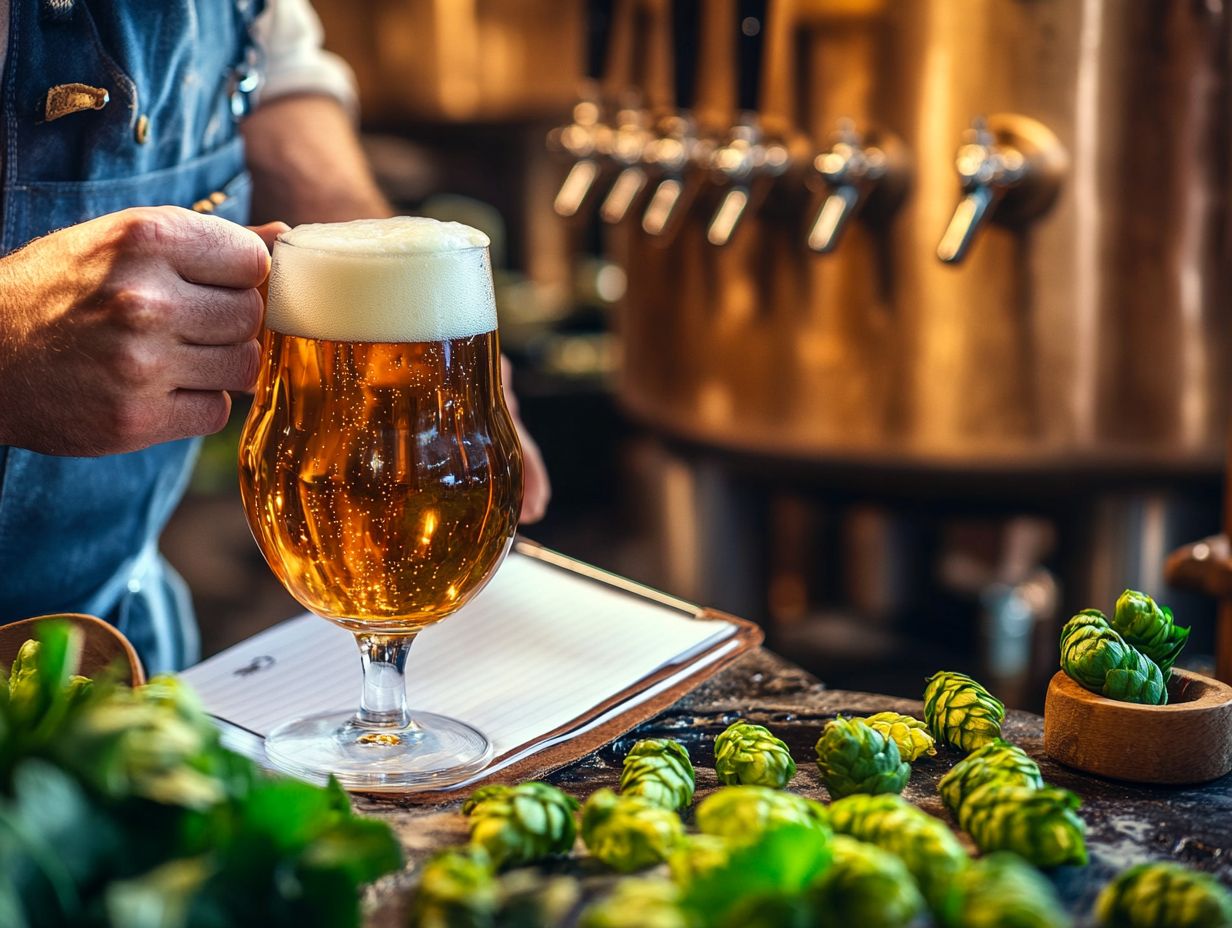
It’s crucial to monitor and adjust pH levels while brewing to avoid off-flavors and ensure your beer reaches its optimum quality.
The pH level plays a significant role in the performance of yeast during fermentation. Ideal ranges typically hover between 4.0 and 5.0. If the pH strays too high or too low, you risk introducing undesirable aromas or flavors, such as astringency or sourness, which can ultimately compromise the overall flavor profile of your brew.
To accurately gauge pH levels, you can rely on pH meters or test strips. These tools enable you to make precise adjustments throughout the brewing process. Incorporating acid or alkaline substances, such as lactic acid or baking soda, can help you bring the pH into the desired range, ensuring that the intended character of your beer is maintained.
5. Properly Store and Handle Beer
Properly storing and handling your beer is crucial for preventing oxidation and off-flavors. This ensures that each sip maintains its intended flavor profile until you’re ready to enjoy it.
Focus on essential factors such as temperature control, light exposure, and effective bottle conditioning techniques. These can significantly extend the life and quality of your favorite brews. Ideally, your beer should find a home in a cool, dark place, away from direct sunlight that can impart skunky flavors to light-sensitive varieties.
Avoiding temperature fluctuations is equally important. Maintaining a steady temperature, ideally between 45 F and 55 F for most beers, is essential for preserving their integrity.
For bottle-conditioned beers, keeping them upright is key to preventing yeast sediment from mingling back into the liquid. These best practices not only uphold the beer’s quality but also elevate your overall drinking experience.
Frequently Asked Questions
What are off-flavors in brewing, and why is it important to detect them early?
Off-flavors, such as green-apple and phenolic flavors, are undesirable tastes or aromas in beer that can ruin its overall quality. It’s important to detect them early to prevent an entire batch of beer from being affected and to ensure a consistent, high-quality product. Identifying off-flavors is a critical aspect of beer evaluation.
What are some common off-flavors found in beer, such as esters or sour flavors, and how can they be detected early?
Some common off-flavors include diacetyl, acetaldehyde, and dimethyl sulfide (DMS). They can be detected early through sensory analysis, chemical testing, and monitoring the brewing process. Sensory analysis can identify esters and overly sweet characteristics, while chemical testing can pinpoint lactic acid from bacteria contamination like Lactobacillus and Pediococcus.
How does sensory analysis, including beer tasting and beer evaluation, help in detecting off-flavors early in brewing?
Sensory analysis involves trained tasters, including beer judges and BJCP program participants, evaluating the appearance, aroma, and taste of beer. This can help detect off-flavors such as a cidery aroma or cloyingly sweet notes that may not be picked up by chemical testing or monitoring the brewing process.
Ready to enhance your brewing skills? Try implementing these practices in your next batch and explore more tips on our website!
What role do chemical tests play in detecting off-flavors early in brewing?
Chemical tests can detect specific compounds known to cause off-flavors in beer. These tests measure flavor thresholds and identify issues like oxidized or lightstruck flavors.
How can monitoring the brewing process, including fermentation, help detect off-flavors early?
Monitoring factors like temperature, pH levels, and fermentation time is crucial. Catching issues early allows for corrective measures to maintain flavor quality.
What steps can be taken to prevent off-flavors and ensure quality beer styles like Oktoberfest and bock?
To keep your beer tasting great, start with high-quality ingredients, maintain sanitation, and monitor the brewing process closely.
Proper handling of bottled beer and using good brewing techniques are essential to avoid off-flavors.

